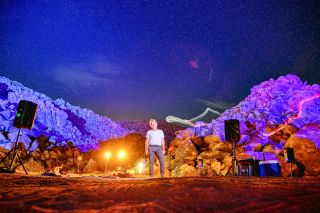Mindfulness
3 Strategies for Listening to Music Mindfully
A heartfelt conversation with rock musician Tim DeLaughter.
Posted May 7, 2024 Reviewed by Devon Frye
Key points
- Mindfully listening to music can improve many aspects of our overall well-being.
- Musician Tim DeLaughter describes creating music as an effort to save himself.
- The act of creating helps him heal, and in turn, we can heal by listening.

Listening to music has been proven to give us a wellness boost. The activity enhances physical and mental well-being, improving our heart rate, motor skills, and even immune system. A musical work that demands listening with full body and mind, which ignites somatic awareness, is the most wonderous of experiences.
With his band The Polyphonic Spree, rock musician Tim DeLaughter seems to repeatedly create albums of that calibre. When their latest, "Salvage Enterprise," came out, I truly could listen to nothing else for weeks. So, after decades of admiring his work from afar, I had to chat with Tim and get some tips from this creative soul on how to better listen.
Listen to the embedded emotion.
At the outset of our talk, Tim shared a striking assertion: “I'm trying to save myself, and that seems to be the only thing I can sing about.”
Maybe that’s why his art has held my attention for over two decades; there is a compelling narrative not only built into each individual album but the entirety of his creative output. “It’s pulling myself forward and reminding myself that I'm capable of these things. That's what seems to be real to me, what I feel comfortable singing about. I love the beauty of the music, to be able to be the soundtrack of that.”
At the same time, Tim says he is not consciously deliberate about what he is putting into the music. “I write my songs out of improvisation. I write in the stream of consciousness… it's either there, or it isn't. And I write the lyrics and the melody and the music all at the same time. I'm not a person that goes, ‘I'm gonna write a song about this.’ It's not like that. It's whatever is in there at that moment.”
This can be part of the trick to giving your brain a workout while listening to music. Mindfully work to uncover the emotions that may be embedded within. Avoid blazing mindlessly through randomized playlists. “This is especially difficult for albums that are rooted in concept, and you want people to hear it from start to finish. We're kind of living in this singles world, where it’s just, consume this, consume that.”
Listen for memories.
Another opportunity that listening to music can afford is the chance to enhance our memory. We know that music can boost memory, and Tim plays with his own recall as he creates:
“I look at The Spree, and I find that all my influences in order to make The Spree have come from when I was a kid… mainly from the second grade, coming out of the first going to second. That age is where I think I really tuned in and realized I like this kind of music. This music appeals to me.
It started with going to the store and getting Walt Disney storybook records as a kid. When I'd get sick, my mom would take me to the pharmacy, and you could buy records there. And I'd buy Walt Disney storybook records from the movies… Those records came with picture books, and you would listen to the record and then follow along in the picture book. They're using orchestral instruments to tell stories and actually give you a visualization of what you're hearing.”
Researchers have found that music doesn't just help us retrieve stored memories but supports creating new ones. Be mindful of what this type of awareness can achieve. Make an effort to uncover the memories that may be brought to the fore through the listening experience while being equally mindful of the new memories that are being soundtracked in real-time.
Ask: Where is the heart and soul of the music?
One motif that has always stood out to me in The Spree’s music is the recurring appearance of the sun. I was curious to find out if at least that creative consistency was mindful and deliberate. Tim said:
“I'm gonna take you back to the same time of me in the second grade. I'm living in Dallas with my mom. My parents are divorced. My mom's a working mom, and we’re in an apartment complex. We lived right outside the swimming pool area in the complex…
I have these memories of walking around that pool with my eyes closed, and just feeling the sun on my face, and hearing music in the background. And to this day, I can close my eyes, and I can still feel that moment, the way the sun made me feel mixed with the music in the background… I look at the sun as a form of healing.”
The theme of healing is at the heart of Tim’s music. The act of creating helps him heal, and in turn, we can heal by listening. This takes on extra power in a live setting:
“When you get that many people dialed into that world and playing this music, it gets really infectious on stage… it's this force and spirit that comes out of The Spree that's unlike anything else I've experienced… But I think it comes from where the music, and the soul of the music, is born from. That is what creates the environment for people to explore in that space.”
Be mindful of music’s soul. When healing is at its essence, the therapeutic power is immense.




